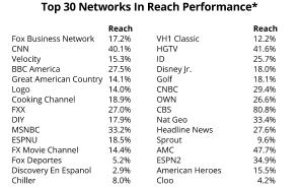
As
advertisers and agencies wrap up their 2016-17 upfront negotiations, they might want to consider an analysis released this morning by an influential Wall Street analyst reviewing changes in the U.S.
audience reach of Nielsen-rated TV networks. While ratings continue to serve as the currency that are the basis of most TV advertising deals, big TV advertisers still utilize media plans that seek to
optimize the reach of viewers in the TV universe.
“While ratings tend to generate the bulk of focus in the press and among investors, reach metrics are often comparably
important to the industry,” Pivotal Research Group analyst Brian Wieser writes in an analysis released this morning showing the rankings of 79 Nielsen-rated TV networks on the basis of their
reach performance over the past 12 months.
While most networks continued to lose reach due to the hyper-fragmentation of the media marketplace, some performed better than others on a
relative basis. The analysis shows how each of the networks performed utilizing a simple average of the change in reach in the 12 months through June 2016.
While the major broadcast
networks continue to deliver the greatest reach -- by a wide margin -- over their next-closest cable competitors, Wieser notes that "a handful of cable networks -- specifically TBS, TNT, FX, USA and
AMX -- stand apart from the pack of cable networks given the broad appeal of the programming each runs, although monthly reach remains only around 50% for them."
That compares with a
reach of about 80% for the Big 4 broadcast networks, but the major broadcast networks also happen to be losing relative reach at a rapid rate.
“There has been some erosion in
reach over the past year of around 1.6%, although CBS has lost less relative to ABC, NBC and Fox,” Wieser notes, adding that with the exception of AMC, the broad appeal cable networks -- TBS,
TNT, FX and USA -- all experienced significant losses of reach that were worse than industry averages.
Overall, Wieser says networks owned by Fox, AMC and Scripps “typically
fared relatively better” than the average, while networks owned by VIacom generally lost the most relative reach.
“For advertisers, television budgets are typically optimized for
reach and frequency,” Wieser writes, explaining the importance of the contribute each network makes to an advertiser’s audience reach delivery.